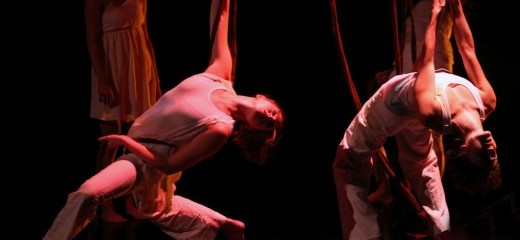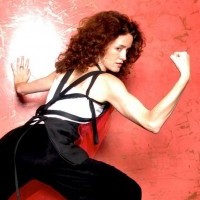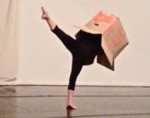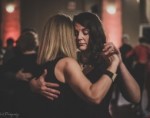
Photo: Bill Hebert
Ties That Bind at the Painted Bride
by Carolyn Merritt
Philadelphia’s thriving contemporary dance scene can often feel like a family. As an audience member at the Painted Bride’s
Ties That Bind, I wondered whether the “ties” referred to the dancers themselves, many of whom work together in other companies. Then again, props evoked physical ties in two of the pieces, while the lighting design constituted a tie of sorts among dancers in the third. The evening included the choreography of Jennifer Morley, Olive Prince Dance, and Nora Gibson Performance Project, offering a nice sampling of the city’s young professionals, as well as food for thought on the ties that manifest in the lifeworld of an art scene, and the pleasures and challenges of shared concerts.
Morley’s Bearing Fruit opened beautifully: a moonlit lullaby enveloped the space, two hammocks suspended on opposing diagonals crisscrossed at center stage, and a spotlight shone on Ellen Gerdes cooing to the sleeping figures within. Beau Hancock and Gina Hoch-Stall joined Gerdes in a diagonal pattern of advance and retreat, punctuated by long scooping gestures, gentle rises and falls, offerings of fruit, and languid spiraling turns, their journey reminiscent of images of human evolution. When Morley and Ellie Goudie-Averill descended from their pods and began a duet from two small metal tubs, the pair alternately reveled in the work’s luscious movement and voluptuous phrasing and broke its even pace with short bursts of powerful leaps.
Themes of conception, fruitfulness and nurturance were reinforced through the title, props, and delicate, supportive partnering. But I often struggled to hear Magira Ross’ recitation of the Eskimo myth, Raven the Creator, and wished for more program notes on the narrative to clarify these moments. The work as a whole depicted a sweet elaboration on birth and life woven through dance, song, and story, sustained by a soothing undercurrent of sound and expert dancing.
Prince’s Under Desire began with a post-apocalyptic figure methodically navigating the dark stage in plié, releasing smoke from a lunchbox-size machine until the space teemed with a misty fog. The lights revealed Jennifer Rose in a short white dress covered in indecipherable writings. A powerhouse and flawless technician, Rose shifted from razor-sharp isolations to rapid-fire scribblings, as if working out an equation in the sand. Silent pleas displaced jutting limbs as she mouthed unheard words, while stunning extensions, breakneck turns, and a pulse-stopping drop to the floor shocked in their precision and beautiful violence.
When the stage went black and Rose disappeared, Prince, Morley, Elizabeth Reynolds, and Caitlin Hellerer surfaced through the fog, entangled in a series of ropes hung from the ceiling. Their hair teased, heavily made-up, white costumes covered in scribbles, faces conjuring drunken yearning, the dancers moved in a constant furor. To the motor of Christopher Farrell’s electronic score and their own breath, they tumbled across the floor, grasped for air, and propelled into every inch of space. While the movement excited, desire here seemed otherworldly and always out of reach, and I wondered at the unchanging desperation of the piece.
Nora Gibson presented an exacting investigation of repetition with revision in Trinity – Phase II, a trio performed with Jessica Warchal-King and Eiren Shuman that bore a striking resemblance to Lucinda Childs’ minimalist studies of patterns. Much of the movement stayed with me – piqué attitude, chaîné turn, attitude turn, port-de-bras, first position – for the complexity of the piece lay in its slowly developing permutations, enacted in ever changing configurations, in response to ever shifting patterns of light and sound. Impressive in these dancers was their stamina, their unchanging expressions, their unfalteringly even tone, and their precise replications. But the dizzying rapture I experienced in the wake of Childs’ Dance evaded me here, and I felt a bit of the exhaustion I saw in the dancers themselves by the end.
Ties That Bind left me full of questions – on collaborative art worlds, on “through lines” in shared concerts, and on the effect of personal ties in the reception of artwork. (In my case, I have known Morley and Prince for years, and I wonder how my familiarity with each, as individual and artist, impacts my take on their work.) The evening also left me with vivid impressions, and a sense of gratitude for the connections and experiments alike fostered by the city’s vibrant dance community.
Ties That Bind: An Evening of Contemporary Choreography by Nora Gibson Performance Project, Jennifer Morley, and Olive Prince Dance. Painted Bride Art Center, December 2-3. No further performances.
Editor Note: The text has been amended in the next-to-last paragraph. In place of describing Nora Gibson's Trinity-Phase II as a dance "taking inspiration from Lucinda Childs' minimalist studies" it now states that the trio "bore a striking resemblance to" Childs' work.
By Carolyn Merritt
December 14, 2011










